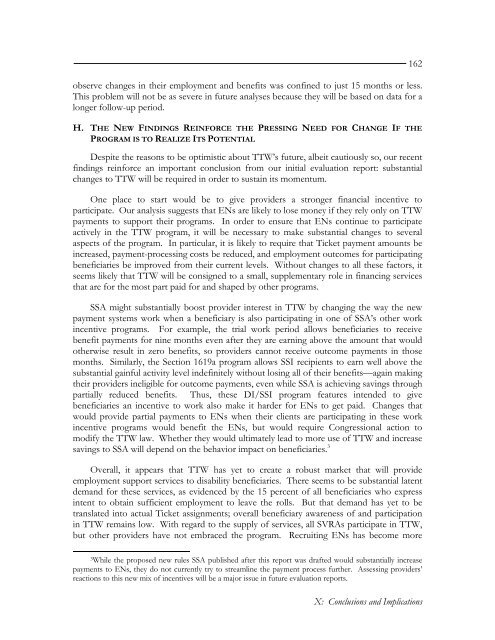Evaluation of the Ticket to Work Program, Implementation ...
Evaluation of the Ticket to Work Program, Implementation ...
Evaluation of the Ticket to Work Program, Implementation ...
You also want an ePaper? Increase the reach of your titles
YUMPU automatically turns print PDFs into web optimized ePapers that Google loves.
observe changes in <strong>the</strong>ir employment and benefits was confined <strong>to</strong> just 15 months or less.This problem will not be as severe in future analyses because <strong>the</strong>y will be based on data for alonger follow-up period.H. THE NEW FINDINGS REINFORCE THE PRESSING NEED FOR CHANGE IF THEPROGRAM IS TO REALIZE ITS POTENTIALDespite <strong>the</strong> reasons <strong>to</strong> be optimistic about TTW’s future, albeit cautiously so, our recentfindings reinforce an important conclusion from our initial evaluation report: substantialchanges <strong>to</strong> TTW will be required in order <strong>to</strong> sustain its momentum.One place <strong>to</strong> start would be <strong>to</strong> give providers a stronger financial incentive <strong>to</strong>participate. Our analysis suggests that ENs are likely <strong>to</strong> lose money if <strong>the</strong>y rely only on TTWpayments <strong>to</strong> support <strong>the</strong>ir programs. In order <strong>to</strong> ensure that ENs continue <strong>to</strong> participateactively in <strong>the</strong> TTW program, it will be necessary <strong>to</strong> make substantial changes <strong>to</strong> severalaspects <strong>of</strong> <strong>the</strong> program. In particular, it is likely <strong>to</strong> require that <strong>Ticket</strong> payment amounts beincreased, payment-processing costs be reduced, and employment outcomes for participatingbeneficiaries be improved from <strong>the</strong>ir current levels. Without changes <strong>to</strong> all <strong>the</strong>se fac<strong>to</strong>rs, itseems likely that TTW will be consigned <strong>to</strong> a small, supplementary role in financing servicesthat are for <strong>the</strong> most part paid for and shaped by o<strong>the</strong>r programs.SSA might substantially boost provider interest in TTW by changing <strong>the</strong> way <strong>the</strong> newpayment systems work when a beneficiary is also participating in one <strong>of</strong> SSA’s o<strong>the</strong>r workincentive programs. For example, <strong>the</strong> trial work period allows beneficiaries <strong>to</strong> receivebenefit payments for nine months even after <strong>the</strong>y are earning above <strong>the</strong> amount that wouldo<strong>the</strong>rwise result in zero benefits, so providers cannot receive outcome payments in thosemonths. Similarly, <strong>the</strong> Section 1619a program allows SSI recipients <strong>to</strong> earn well above <strong>the</strong>substantial gainful activity level indefinitely without losing all <strong>of</strong> <strong>the</strong>ir benefits—again making<strong>the</strong>ir providers ineligible for outcome payments, even while SSA is achieving savings throughpartially reduced benefits. Thus, <strong>the</strong>se DI/SSI program features intended <strong>to</strong> givebeneficiaries an incentive <strong>to</strong> work also make it harder for ENs <strong>to</strong> get paid. Changes thatwould provide partial payments <strong>to</strong> ENs when <strong>the</strong>ir clients are participating in <strong>the</strong>se workincentive programs would benefit <strong>the</strong> ENs, but would require Congressional action <strong>to</strong>modify <strong>the</strong> TTW law. Whe<strong>the</strong>r <strong>the</strong>y would ultimately lead <strong>to</strong> more use <strong>of</strong> TTW and increasesavings <strong>to</strong> SSA will depend on <strong>the</strong> behavior impact on beneficiaries. 3Overall, it appears that TTW has yet <strong>to</strong> create a robust market that will provideemployment support services <strong>to</strong> disability beneficiaries. There seems <strong>to</strong> be substantial latentdemand for <strong>the</strong>se services, as evidenced by <strong>the</strong> 15 percent <strong>of</strong> all beneficiaries who expressintent <strong>to</strong> obtain sufficient employment <strong>to</strong> leave <strong>the</strong> rolls. But that demand has yet <strong>to</strong> betranslated in<strong>to</strong> actual <strong>Ticket</strong> assignments; overall beneficiary awareness <strong>of</strong> and participationin TTW remains low. With regard <strong>to</strong> <strong>the</strong> supply <strong>of</strong> services, all SVRAs participate in TTW,but o<strong>the</strong>r providers have not embraced <strong>the</strong> program. Recruiting ENs has become more1623 While <strong>the</strong> proposed new rules SSA published after this report was drafted would substantially increasepayments <strong>to</strong> ENs, <strong>the</strong>y do not currently try <strong>to</strong> streamline <strong>the</strong> payment process fur<strong>the</strong>r. Assessing providers’reactions <strong>to</strong> this new mix <strong>of</strong> incentives will be a major issue in future evaluation reports.X: Conclusions and Implications
















